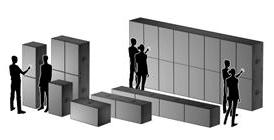Jun 18 2010
The Chilean Pavilion will showcase a multi-touch modular display LCD screen during October 2010 in the Expo 2010 Shanghai China.
The leading interactive display manufacturing company, Riolab, and MultiTouch, creator of the first modular based multi-touch LCD screen to be used for large scale displays, have jointly developed this largest multitouch display for a World’s fair. This display wall, known as the ‘Muro de Chile’ or the Wall of Chile, measures is four meters long and 1.2 meters high.
 Multitouch LCD for modular display arrays
Multitouch LCD for modular display arrays
The Wall of Chile, designed in Santiago, Chile, by a team led by Francisco Arevalo, was developed in four months. CTO Tommi Ilmonen, CTO of MultiTouch headed the technical integration phase of the development.
Programming of the MultiTouch Cell device, a 46-inch sized stackable LCD display, was done by utilizing the MultiTouch Cornerstone software that facilitates dynamic integration of applications.
The patented computer vision system of MultiTouch has been complemented by software that transforms touch to provide the programming experience. MultiTouch has offered the initial native Windows 7 multitouch applications at CES 2010 for the MultiTouch Cell displays.
The company has recently introduced its Cornerstone software. This software is able to support a broad range of programming languages, protocols, and development environments like TUIO and XML stream, Silverlight, Adobe Flash/Flex/Air, .NET, C++/OpenGL, Microsoft Visual Studio, and many more.
This display wall will help visitors to view many photographs from Chile’s historical archives and high-definition video that lasts for more than six hours, including terrestrial, satellite, and natural images that highlight the Chilean character and culture.
The wall uses a 16.5 mega-pixel main interface in the form of a large scale map of Chile. It provides head-spots of thirty six persons through which more information can be assessed. Hundreds of private and public institutions and more than four hundred authors have contributed directly to the content of the wall.
Texts and images have are uploaded to the website of the Wall of Chile, at www.murodechile.cl. They appear at the screen’s bottom in a grid and are updated automatically every day.